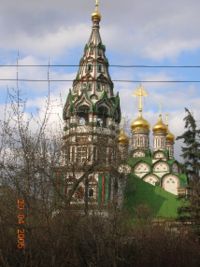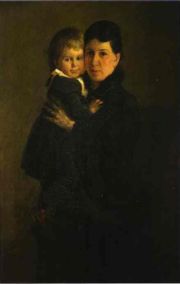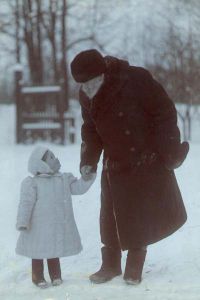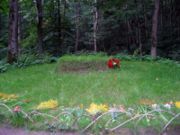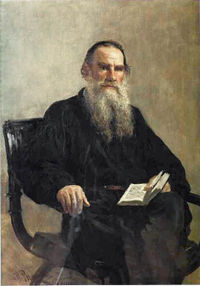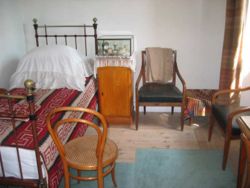Leo Tolstoy
2007 Schools Wikipedia Selection. Related subjects: Writers and critics
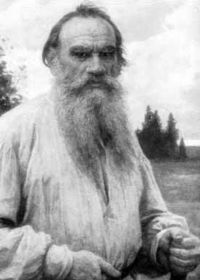 Leo Tolstoy, late in life. |
|
| Born: | August 28 1828 Yasnaya Polyana, Russia |
|---|---|
| Died: | 20 November 1910 Astapovo, Russia |
| Occupation(s): | Novelist |
| Genre(s): | realistic fiction |
| Literary movement: | Christian anarchist pacifist |
| Influenced: | Mahatma Gandhi Martin Luther King, Jr. |
Count Lev Nikolayevich Tolstoy (Russian: Лев Никола́евич Толсто́й ( help· info), Lev Nikolaevič Tolstoj), commonly referred to in English as Leo Tolstoy ( September 9, 1828 [ O.S. August 28] – November 20, 1910 [ O.S. November 7]) was a Russian novelist, writer, essayist, philosopher, Christian anarchist, pacifist, educational reformer, vegetarian, moral thinker and an influential member of the Tolstoy family.
Tolstoy is widely regarded as one of the greatest of all novelists, particularly noted for his masterpieces War and Peace and Anna Karenina; in their scope, breadth and realistic depiction of Russian life, the two books stand at the peak of realistic fiction. As a moral philosopher he was notable for his ideas on nonviolent resistance through his work The Kingdom of God is Within You, which in turn influenced such twentieth-century figures as Mahatma Gandhi and Martin Luther King, Jr.
Biography
Count Leo (pronounced in his family circle as "Lyov", not "Lev") was born on his father's estate of Yasnaya Polyana, in the Tula guberniya of Central Russia. The Tolstoys are a well-known family of old Russian nobility, the writer's mother was born a Princess Volkonsky, while his grandmothers came from the Troubetzkoy and Gorchakov princely families. Tolstoy was connected to the grandest families of Russian aristocracy; Alexander Pushkin was his fourth cousin. The fact of belonging by birth to the best Russian nobility marks off Tolstoy very distinctly from the other writers of his generation. He always remained a class-conscious nobleman who cherished his impeccable French pronunciation and kept aloof from the intelligentsia.
Early life
Tolstoy's childhood and boyhood were passed between Moscow and Yasnaya Polyana, in a large family of three brothers and a sister. He has left us an extraordinarily vivid record of his early human environment in the wonderful notes he wrote for his biographer Pavel Biryukov. He lost his mother when he was two, and his father when he was nine. His subsequent education was in the hands of his aunt, Madame Ergolsky, who is supposed to be the starting point of Sonya in War and Peace. (His father and mother are respectively the starting points for the characters of Nicholas Rostov and Princess Marya in the same novel).
In 1844, Tolstoy began studying law and Oriental languages at Kazan University, where teachers described him as "both unable and unwilling to learn." He found no meaning in further studies and left the university in the middle of a term. In 1849 he settled down at Yasnaya Polyana, where he attempted to be useful to his peasants but soon discovered the ineffectiveness of his uninformed zeal.
Much of the life he led at the university and after leaving it was of a kind usual with young men of his class, irregular and full of pleasure-seeking — wine, cards, and women — not entirely unlike the life led by Pushkin before his exile to the south. But Tolstoy was incapable of that lighthearted acceptance of life as it came. From the very beginning, his diary (which is extant from 1847 on) reveals an insatiate thirst for a rational and moral justification of life, a thirst that forever remained the ruling force of his mind. The same diary was his first experiment in forging that technique of psychological analysis which was to become his principal literary weapon.
Military career and first literary efforts
Tolstoy's first literary effort was a translation of A Sentimental Journey Through France and Italy. Sterne's influence on his early works was substantial, although he subsequently denigrated him as "a devious writer". To the year 1851 belongs his first attempt at a more ambitious and more definitely creative kind of writing, his first short story, "A History of Yesterday". In the same year, sick of his seemingly empty and useless life in Moscow, which brought heavy gambling debts, he went to the Caucasus, where he joined an artillery unit garrisoned in the Cossack part of Chechnya, as a volunteer of private rank, but of noble birth (юнкер). In 1852 he completed his first novel Childhood and sent it to Nikolai Nekrasov for publication in the Sovremennik. Although Tolstoy was annoyed with the publishing cuts, the story had an immediate success and gave Tolstoy a definite place in Russian literature.
In his battery Tolstoy lived the rather easy and unoccupied life of a noble officer of means. He had much spare time, and most of it was spent in hunting. In the little fighting he saw, he did very well. In 1854 he received his commission and was, at his request, transferred to the army operating against the Turks in Wallachia, where he took part in the siege of Silistra (located in North-Eastern Bulgaria). In November of the same year he joined the garrison of Sevastopol. There he saw some of the most serious fighting of the century. He took part in the defense of the famous Fourth Bastion and in the Battle of Chernaya River, the bad management of which he satirized in a humorous song, the only piece of verse he is known to have written.
In Sevastopol he wrote the Sebastopol Sketches, widely viewed as his first approach to the techniques to be used so effectively in War and Peace. Appearing as they did in the Sovremennik monthly while the siege was still on, the stories greatly increased the general interest in their author. In fact, the Tsar Alexander II was known to have said in praise of the author of the work, "Guard well the life of that man." Soon after the abandonment of the fortress, Tolstoy went on leave of absence to Petersburg and Moscow. The following year he left the army, thoroughly disgusted with the meaningless carnage he had witnessed.
Between retirement and marriage
The years 1856-61 were passed between Petersburg, Moscow, Yasnaya, and foreign countries. In 1857 (and again in 1860-61) he traveled abroad and returned disillusioned by the selfishness and materialism of European bourgeois civilization, a feeling expressed in his short story Lucerne and more circuitously in Three Deaths. As he drifted towards a more oriental worldview with Buddhist overtones, Tolstoy learned to feel himself in other living creatures. He started to write Kholstomer, which contains a passage of interior monologue by a horse. Many of his intimate thoughts were repeated by a protagonist of The Cossacks, who reflects, falling on the ground while hunting in a forest:
'Here am I, Dmitri Olenin, a being quite distinct from every other being, now lying all alone Heaven only knows where – where a stag used to live – an old stag, a beautiful stag who perhaps had never seen a man, and in a place where no human being has ever sat or thought these thoughts. Here I sit, and around me stand old and young trees, one of them festooned with wild grape vines, and pheasants are fluttering, driving one another about and perhaps scenting their murdered brothers.' He felt his pheasants, examined them, and wiped the warm blood off his hand onto his coat. 'Perhaps the jackals scent them and with dissatisfied faces go off in another direction: above me, flying in among the leaves which to them seem enormous islands, mosquitoes hang in the air and buzz: one, two, three, four, a hundred, a thousand, a million mosquitoes, and all of them buzz something or other and each one of them is separate from all else and is just such a separate Dmitri Olenin as I am myself.' He vividly imagined what the mosquitoes buzzed: 'This way, this way, lads! Here's some one we can eat!' They buzzed and stuck to him. And it was clear to him that he was not a Russian nobleman, a member of Moscow society, the friend and relation of so-and-so and so-and-so, but just such a mosquito, or pheasant, or deer, as those that were now living all around him. 'Just as they, just as Uncle Eroshka, I shall live awhile and die, and as he says truly: "grass will grow and nothing more".'
These years after the Crimean War were the only time in Tolstoy's life when he mixed with the literary world. He was welcomed by the litterateurs of Petersburg and Moscow as one of their most eminent fellow craftsmen. As he confessed afterwards, his vanity and pride were greatly flattered by his success. But he did not get on with them. He was too much of an aristocrat to like this semi-Bohemian intelligentsia. All the structure of his mind was against the grain of the progressive Westernizers, epitomized by Ivan Turgenev, who was widely considered the greatest living Russian author of the period. Turgenev, who was in many ways Tolstoy's opposite was also one of his strongest praises calling Tolstoy's 1862 short novel The Cossacks, "The best story written in our language."
Tolstoy did not believe in progress and culture and liked to tease Turgenev by his outspoken or cynical statements. His lack of sympathy with the literary world culminated in a resounding quarrel with Turgenev (1861), whom he challenged to a duel but afterwards apologized for so doing. The whole story is very characteristic and revelatory of his character, with its profound impatience of other people's assumed superiority and their perceived lack of intellectual honesty. The only writers with whom he remained friends were the conservative "landlordist" Afanasy Fet and the democratic Slavophile Nikolay Strakhov, both of them entirely out of tune with the main current of contemporary thought.
In 1859 he started a school for peasant children at Yasnaya, followed by twelve others, whose ground-breaking libertarian principles Tolstoy described in his 1862 essay, "The School at Yasnaya Polyana". He also authored a great number of stories for peasant children. Tolstoy's educational experiments were short-lived, but as a direct forerunner to A.S.Neill's Summerhill School, the school at Yasnaya Polyana can justifiably be claimed to be the first example of a coherent theory of libertarian education.
In 1862 Tolstoy published a pedagogical magazine, Yasnaya Polyana, in which he contended that it was not the intellectuals who should teach the peasants, but rather the peasants the intellectuals. He came to believe that he was undeserving of his inherited wealth, and gained renown among the peasantry for his generosity. He would frequently return to his country estate with vagrants whom he felt needed a helping hand, and would often dispense large sums of money to street beggars while on trips to the city. In 1861 he accepted the post of Justice of the Peace, a magistrature that had been introduced to supervise the carrying into life of the Emancipation reform of 1861.
Meanwhile his insatiate quest for moral stability continued to torment him. He had now abandoned the wild living of his youth, and thought of marrying. In 1856 he made his first unsuccessful attempt to marry (Mlle Arseniev). In 1860 he was profoundly affected by the death of his brother Nicholas, which was for him the first encounter with the inevitable reality of death. After these reverses, Tolstoy reflected in his diary that at thirty four, no woman could love him, since he was too old and ugly. In 1862, at last, he proposed to Sofia Andreyevna Behrs and was accepted. They were married on 23 September of the same year.
Marriage and family life
His marriage is one of the two most important landmarks in the life of Tolstoy, the other being his conversion. Once he entertained a passionate and hopeless aspiration after that whole and unreflecting "natural" state which he found among the peasants, and especially among the Cossacks in whose villages he had lived in the Caucasus. His marriage provided for him an escape from unrelenting self-questioning. It was the gate towards a more stable and lasting "natural state". Family life, and an unreasoning acceptance of and submission to the life to which he was born, now became his religion.
For the first fifteen years of his married life he lived in this blissful state of confidently satisfied life, whose philosophy is expressed with supreme creative power in War and Peace. Sophie Behrs, almost a girl when he married her and 16 years his junior, proved an ideal wife and mother and mistress of the house. On the eve of their marriage, Tolstoy gave her his diaries detailing his sexual relations with female serfs. Together they had thirteen children, five of whom died in their childhoods.
Sophie was, moreover, a devoted help to her husband in his literary work, and the story is well known how she copied out War and Peace seven times from beginning to end. The family fortune, owing to Tolstoy's efficient management of his estates and to the sales of his works, was prosperous, making it possible to provide adequately for the increasing family.
Conversion
Tolstoy had always been fundamentally a rationalist. But at the time he wrote his great novels his rationalism was suffering an eclipse. The philosophy of War and Peace and Anna Karenina (which he formulates in A Confession as "that one should live so as to have the best for oneself and one's family") was a surrender of his rationalism to the inherent irrationalism of life. The search for the meaning of life was abandoned. The meaning of life was Life itself. The greatest wisdom consisted in accepting without sophistication one's place in Life and making the best of it. But already in the last part of Anna Karenina a growing disquietude becomes very apparent. When he was writing it the crisis had already begun that is so memorably recorded in A Confession and from which he was to emerge the prophet of a new religious and ethical teaching.
Following this conversion, the details of which are given below, Tolstoy's rationalism found satisfaction in the admirably constructed system of his doctrine. But the irrational Tolstoy remained alive beneath the hardened crust of crystallized dogma. Tolstoy's diaries reveal that the desires of the flesh were active in him till an unusually advanced age; and the desire for expansion, the desire that gave life to War and Peace, the desire for the fullness of life with all its pleasure and beauty, never died in him. We catch few glimpses of this in his writings, for he subjected them to a strict and narrow discipline. His magic touch did not suffer from his conversion, however. He wrote as effortlessly as ever and his late years produced admirable works of art, such as Hadji Murat, one of many pieces that appeared posthumously. It became increasingly apparent, that, in the words of Vladimir Nabokov, there were only two subjects that Tolstoy was really interested in and thought worth writing about — and these were life and death. The relationship between life and death was examined by him over and over again, with increasing complexity, in the final version of Kholstomer, in The Death of Ivan Ilyich, in How Much Land Does a Man Need?
Later life
Soon after A Confession became known, Tolstoy began, at first against his will, to recruit disciples. The first of these was Vladimir Chertkov, an ex-officer of the Horse Guards and founder of the Tolstoyans, described by D.S. Mirsky as a "narrow fanatic and a hard, despotic man, who exercised an enormous practical influence on Tolstoy and became a sort of grand vizier of the new community". Tolstoy also established contact with certain sects of Christian communists and anarchists, like the Dukhobors. Despite his unorthodox views and support for Thoreau's doctrine of civil disobedience, Tolstoy was unmolested by the government, solicitous to avoid negative publicity abroad. Only in 1901 the Synod excommunicated him. This act, widely but rather unjudiciously resented both at home and abroad, merely registered a matter of common knowledge — that Tolstoy had ceased to be an Orthodox Church-man.
As his reputation among people of all classes grew immensely, a few Tolstoyan communes formed throughout Russia in order to put into practice Tolstoy's religious doctrines. And, by the last two decades of his life, Tolstoy enjoyed a place in the world's esteem that had not been held by any man of letters since the death of Voltaire. Yasnaya Polyana became a new Ferney — or even more than that, almost a new Jerusalem. Pilgrims from all parts flocked there to see the great old man. But Tolstoy's own family remained hostile to his teaching, with the exception of his youngest daughter Alexandra Tolstaya. His wife especially took up a position of decided opposition to his new ideas. She refused to give up her possessions and asserted her duty to provide for her large family. Tolstoy renounced the copyright of his new works but had to surrender his landed property and the copyright of his earlier works to his wife. His late marriage life has been described by A. N. Wilson as one of the unhappiest in literary history.
Tolstoy was remarkably healthy for his age, but he fell seriously ill in 1901 and had to live for a long time in Gaspra and Simeiz, Crimea. Still he continued working to the last and never showed the slightest sign of any weakening of brain power. Ever more oppressed by the apparent contradiction between his preaching of communism and the easy life he led under the regime of his wife, full of a growing irritation against his family, which was urged on by Chertkov, he finally left Yasnaya, in the company of his daughter Alexandra and his doctor, for an unknown destination. After some restless and aimless wandering he headed for a convent where his sister was the mother superior but had to stop at Astapovo junction. There he was laid up in the stationmaster's house and died on November 7, 1910. He was buried in a simple peasant's grave in a wood 500 meters from Yasnaya Polyana. Thousands of peasants lined the streets at his funeral.
Novels and fictional works
Tolstoy's fiction consistently attempts to convey realistically the Russian society in which he lived. Matthew Arnold commented that Tolstoy's work is not art, but a piece of life. Arnold's assessment was echoed by Isaak Babel who said that, "if the world could write by itself, it would write like Tolstoy".
His first publications were three autobiographical novels, Childhood, Boyhood, and Youth (1852–1856). They tell of a rich landowner's son and his slow realization of the differences between him and his peasants. Although in later life Tolstoy rejected these books as sentimental, a great deal of his own life is revealed, and the books still have relevance for their telling of the universal story of growing up.
Tolstoy served as a second lieutenant in an artillery regiment during the Crimean War, recounted in his Sevastapol Sketches. His experiences in battle helped develop his pacifism, and gave him material for realistic depiction of the horrors of war in his later work.
The Cossacks (1863) is an unfinished novel which describes the Cossack life and people through a story of Dmitri Olenin, a Russian aristocrat in love with a Cossack girl. This text was acclaimed by Ivan Bunin as one of the finest in the language. The magic of Tolstoy's language is naturally lost in translation, but the following excerpt may give some idea as to the lush, sensuous, pulsing texture of the original:
Along the surface of the water floated black shadows, in which the experienced eyes of the Cossack detected trees carried down by the current. Only very rarely sheet-lightning, mirrored in the water as in a black glass, disclosed the sloping bank opposite. The rhythmic sounds of night — the rustling of the reeds, the snoring of the Cossacks, the hum of mosquitoes, and the rushing water, were every now and then broken by a shot fired in the distance, or by the gurgling of water when a piece of bank slipped down, the splash of a big fish, or the crashing of an animal breaking through the thick undergrowth in the wood. Once an owl flew past along the Terek, flapping one wing against the other rhythmically at every second beat.
War and Peace is generally thought to be one of the greatest novels ever written, remarkable for its breadth and unity. Its vast canvas includes 580 characters, many historical, others fictional. The story moves from family life to the headquarters of Napoleon, from the court of Alexander I of Russia to the battlefields of Austerlitz and Borodino. The novel explores Tolstoy's theory of history, and in particular the insignificance of individuals such as Napoleon and Alexander. But more importantly, Tolstoy's imagination created a world that seems to be so believable, so real, that it's not easy to realize that most of his characters actually never existed and that Tolstoy never witnessed the epoch described in the novel.
Somewhat surprisingly, Tolstoy did not consider War and Peace to be a novel (nor did he consider many of the great Russian fictions written at that time to be novels). It was to him an epic in prose. Anna Karenina (1877), which Tolstoy regarded as his first true novel, was one of his most impeccably constructed and compositionally sophisticated works. It tells parallel stories of an adulterous woman trapped by the conventions and falsities of society and of a philosophical landowner (much like Tolstoy), who works alongside the peasants in the fields and seeks to reform their lives. His last novel was Resurrection, published in 1899, which told the story of a nobleman seeking redemption for a sin committed years earlier and incorporated many of Tolstoy's refashioned views on life.
Tolstoy's later work is often criticised as being overly didactic and patchily written, but derives a passion and verve from the depth of his austere moral views. The sequence of the temptation of Sergius in Father Sergius, for example, is among his later triumphs. Gorky relates how Tolstoy once read this passage before himself and Chekhov and that Tolstoy was moved to tears by the end of the reading. Other later passages of rare power include the crises of self faced by the protagonists of After the Ball and Master and Man, where the main character (in After the Ball) or the reader (in Master and Man) is made aware of the foolishness of the protagonists' lives.
Tolstoy had an abiding interest in children and children's literature and wrote tales and fables. Some of his fables are free adaptations of fables from Aesop and from Hindu tradition.
Reputation
Tolstoy's contemporaries paid him lofty tributes: Dostoevsky thought him the finest of all living writers while Gustave Flaubert compared him to Shakespeare and gushed: "What an artist and what a psychologist!". Anton Chekhov, who often visited Tolstoy at his country estate, wrote: "When literature possesses a Tolstoy, it is easy and pleasant to be a writer; even when you know you have achieved nothing yourself and are still achieving nothing, this is not as terrible as it might otherwise be, because Tolstoy achieves for everyone. What he does serves to justify all the hopes and aspirations invested in literature."
Later critics and novelists continue to bear testaments to his art: Virginia Woolf went on to declare him "greatest of all novelists", and James Joyce noted: "He is never dull, never stupid, never tired, never pedantic, never theatrical!". Thomas Mann wrote of his seemingly guileless artistry—"Seldom did art work so much like nature"—sentiments shared in part by many others, including Marcel Proust, William Faulkner, Vladimir Nabokov, who placed him above all other Russian fiction writers, even Gogol, and equalled him with Pushkin among Russian poets.
Religious and political beliefs
At approximately the age of 50, Tolstoy had a mid-life crisis, at which point he determined that he could not go on living without knowing the meaning of life, and so he vowed to either find it or commit suicide. After exploring a variety of areas, he found his answer in the teachings of Jesus, which in his interpretation have strong Buddhist overtones. He relates the story of his mid-life crisis in A Confession, and the conclusions of his studies in My Religion, The Kingdom of God is Within You, and The Gospels in Brief.
The teaching of mature Tolstoy is a rationalized "Christianity", stripped of all tradition and all positive mysticism. He rejected personal immortality and concentrated exclusively on the moral teaching of the Gospels. Of the moral teaching of Christ, the words "Resist not evil" were taken to be the principle out of which all the rest follows. He rejected the authority of the Church, which sanctioned the State, and he condemned the State, which sanctioned violence and corruption. His condemnation of every form of compulsion authorizes us to classify Tolstoy's teaching, in its political aspect, as Christian anarchism.
Christian anarchism
Though he did not call himself an anarchist because he applied the term to those who wanted to change society through violence, Tolstoy is commonly regarded as an anarchist. Tolstoy's Christian beliefs were based on the Sermon on the Mount, and particularly on the phrase about turn the other cheek, which he saw as a justification for pacifism, nonviolence and nonresistance. Tolstoy believed being a Christian made him a pacifist and, due to the military force used by his government, being a pacifist made him an anarchist.
Tolstoy's doctrine of nonresistance ( nonviolence) when faced by conflict is another distinct attribute of his philosophy based on Christ's teachings. By directly influencing Mahatma Gandhi with this idea through his work The Kingdom of God is Within You, Tolstoy has had a huge influence on the nonviolent resistance movement to this day. He also opposed private property and the institution of marriage and valued the ideals of chastity and sexual abstinence (discussed in Father Sergius and his preface to The Kreutzer Sonata), ideals also held by the young Gandhi.
In hundreds of essays over the last twenty years of his life, Tolstoy reiterated the anarchist critique of the State and recommended books by Kropotkin and Proudhon to his readers, whilst rejecting anarchism's espousal of violent revolutionary means, writing in the 1900 essay, "On Anarchy":
The Anarchists are right in everything; in the negation of the existing order, and in the assertion that, without Authority, there could not be worse violence than that of Authority under existing conditions. They are mistaken only in thinking that Anarchy can be instituted by a revolution. But it will be instituted only by there being more and more people who do not require the protection of governmental power ... There can be only one permanent revolution - a moral one: the regeneration of the inner man.
Pacifism
Despite his misgivings about anarchist violence, Tolstoy took risks to circulate the prohibited publications of anarchist thinkers in Russia, and corrected the proofs of Peter Kropotkin's "Words of a Rebel", illegally published in St Petersburg in 1906. Two years earlier, during the Russo-Japanese War, Tolstoy publicly condemned the war and wrote to the Japanese Buddhist priest Soyen Shaku in a failed attempt to make a joint pacifist statement.
A letter Tolstoy wrote in 1908 to an Indian newspaper entitled " Letter to a Hindu" resulted in intense correspondence with Mohandas Gandhi, who was in South Africa at the time and was beginning to become an activist. Reading "The Kingdom of God is Within You" had convinced Gandhi to abandon violence and espouse nonviolent resistance, a debt Gandhi acknowledged in his autobiography, calling Tolstoy "the greatest apostle of non-violence that the present age has produced". The correspondence between Tolstoy and Gandhi would only last a year, from October 1909 until Tolstoy's death in November 1910, but led Gandhi to give the name the Tolstoy Colony to his second ashram in South Africa. Besides non-violent resistance, the two men shared a common belief in the merits of vegetarianism, the subject of several of Tolstoy's essays (see Christian vegetarianism).
Along with his growing idealism, Tolstoy also became a major supporter of the Esperanto movement. Tolstoy was impressed by the pacifist beliefs of the Doukhobors and brought their persecution to the attention of the international community, after they burned their weapons in peaceful protest in 1895. He aided the Doukhobors in migrating to Canada.
